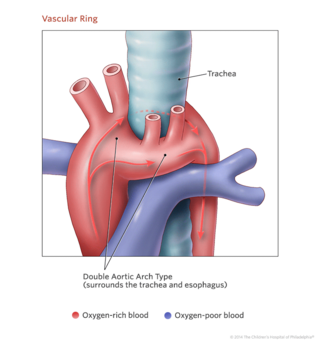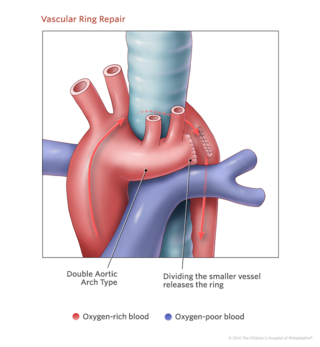What is a vascular ring?
A vascular ring occurs when the aorta (the large artery that carries oxygenated blood out of the heart) or its branches form a complete ring around the trachea (the tube that carries air to the lungs) and the esophagus (the tube that carries food to the stomach). This happens when certain parts of the aorta that normally disappear during fetal development persist abnormally.
“Vascular” means relating to blood vessels (veins and arteries). The condition is called “vascular ring” because the aorta — or other, related arteries — encircles the trachea and esophagus.
Normally, the aorta starts at the left ventricle of the heart as one large vessel: it arches up (the aortic arch) to the left of the trachea and then down (the descending aorta). Arteries that deliver blood to the head, arms and other parts of the upper body branch off at the top of the arch. Arteries that deliver blood to the abdomen, legs and other parts of the lower body branch off from the descending aorta.
There are different types of vascular rings. The most common are:
Double aortic arch
The aorta starts normally at the heart as one large vessel, but then divides into two arches: one on each side of the trachea and esophagus. The two arches then come back together into one vessel (the descending aorta).

Right aortic arch with left ligamentum arteriosum
The aorta starts off to the right, instead of the left (as is normal), and gives off an abnormal branch from the descending aorta. This abnormal branch passes behind the esophagus and gives off the vessel to the left arm (the left subclavian artery) and the ligamentum arteriosum. The ligamentum arteriosum is a remnant of a blood vessel that exists normally in the fetus; it runs between the aorta and the pulmonary artery, and in doing so completes the ring and also might constrict the trachea and/or esophagus.
The structure of the vascular ring and its relationship to the trachea and esophagus varies from child to child. The Cardiac Center team will explain your child’s condition in detail.
Signs and symptoms of vascular rings
The following symptoms may be present in children with vascular rings:
- Noisy or labored breathing, especially with eating
- Difficulty eating and swallowing: the child regurgitates milk or other food
- Dysphagia: the child feels like something is “stuck in the throat”; the child keeps choking or feels like he or she is choking on food
- Persistent cough
- Acid reflux
Testing and diagnosis for vascular rings
In most cases, the symptoms of a vascular ring are mild. That means the condition may go undiagnosed until your child is older, or even an adult. If the condition is severe and your child has trouble breathing, a vascular ring may be diagnosed at several weeks or months of age.
Diagnosis of a vascular ring may require some or all of these tests:
- Chest X-ray
- Cardiac MRI : a three-dimensional image that shows heart and vessel structures in detail
- Chest CT (CAT scan)
- Echocardiogram : sound waves create an image of the heart
- Bronchoscopy: a doctor looks at the trachea using an instrument called a bronchoscope (while patient is under anesthesia)
- Gastrointestinal tests such as barium swallow
Treatment of vascular rings
Vascular rings require surgery (not open heart) if there are symptoms. In most cases, the surgeon makes an incision on the left side of the chest and goes between the ribs to access the area.
For double aortic arch
The surgeon will cut and stitch closed one of the arches (usually the left) so the aorta no longer encircles or puts pressure on the trachea or esophagus.

Right aortic arch with left ligamentum arteriosum
The surgeon divides the ligamentum arteriosum so that it no longer constricts the trachea or esophagus. (The right aortic arch remains, as a person can live with this irregularity.)
The Cardiac Center team will explain your child’s surgery in more detail.
In some cases, a child has no symptoms of vascular ring and the condition is discovered during an unrelated medical test, procedure or evaluation. Instead of surgery, a Cardiac Center team will monitor the child to make sure symptoms don’t appear and the condition isn’t harming the child's health.
The procedure to correct vascular ring is considered low risk. In cases where there are symptoms as outlined above, surgery is recommended.
Outlook for vascular rings
Because of enormous strides in medicine and technology, today most children with heart defects such as vascular rings will go on to lead productive lives as adults.
Follow-up care
Through age 18
In most cases, children with vascular rings recover completely after surgery and won’t need additional procedures. It is not uncommon for noisy breathing to continue for several weeks or months after surgery as the trachea slowly takes on a more normal shape. Sometimes, symptoms such as coughing or labored breathing continue after surgery because the airway is soft (called malacia). We will monitor your child to make sure recovery is as complete and rapid as possible.
Our pediatric cardiologists will follow your child until she is a young adult, coordinating care with her primary care physician. She will need to carefully follow the medical team’s advice.
Into adulthood
Children born with vascular rings who do not require surgery should follow up with a cardiologist. We will help patients transition care to an adult cardiologist.
The Philadelphia Adult Congenital Heart Center, a joint program of Children’s Hospital of Philadelphia and Penn Medicine, meets the unique needs of adults who were born with heart defects.

Why Choose Us
Our specialists are leading the way in the diagnosis, treatment, and research of congenital and acquired heart conditions.
Resources to help
Cardiac Center Resources
We know that caring for a child with a heart condition can be stressful. To help you find answers to your questions – either before or after visiting the Cardiac Center – we’ve created this list of educational health resources.
Reviewed by Meryl S. Cohen, MD, MSEd
Reviewed on 08/05/2024
